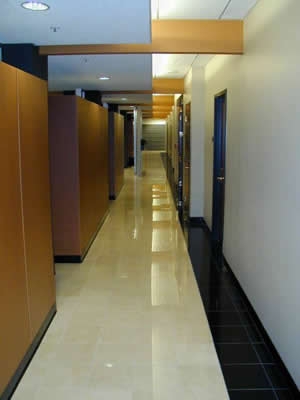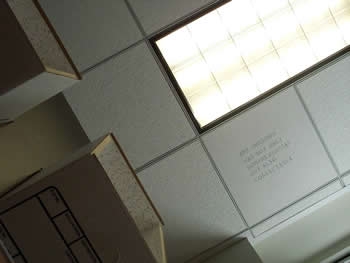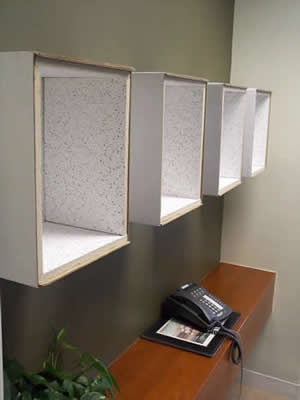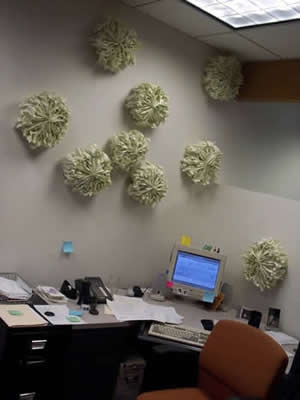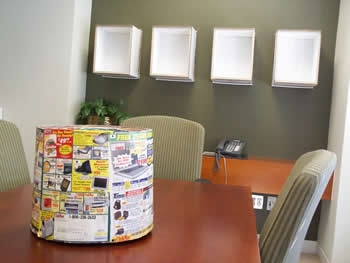Feature: Reviews
la perruque (the wig)
- the office/gallery
- San Francisco
- August 13, 2001 — mid-November 2001
Curated by Amy Balkin and Sean Fletcher
Artists include Peter E.V. Allen, Amy Balkin, Amy Francheschini, Lissa Ivy, Josh On, Timothy Hutchings, Fallout, and Indigo Som
I went to visit the office/gallery in the middle of the workday and explained the outing to my employer as an “off-site meeting.” The simple, subversive act of using company time for one’s personal ends is a widely practiced phenomenon and is the subject of the current exhibition at the office/gallery, oddly entitled la perruque (the wig). The office/gallery is a by-appointment-only location for work by contemporary artists operated covertly in the San Francisco offices of a national insurance and securities firm. The exhibition and title are loosely inspired by Michel de Certeau’s philosophical text, The Practice of Everyday Life. The wig is a concept that means “the workers create their own work disguised as work for their employer.” Each of the artists in the show exposes their habit of stealing time on the job to pursue their own creative habits.
Masking the creation of art while on the job can be a tricky endeavor. Whether scanning legal documents as a source for a text piece, stealing office supplies for the creation of sculpture, or mapping physical labor performed on the job, each artist participating in the wig has carefully manipulated the act of labor into the creation of art. In some cases, they have simply taken materials associated with their work — pads of paper or computer catalogs — and turned them into sculptural objects. In every case, the artists use work time to draw inspiration from the vernacular landscape of office culture and transform them into meditations on exploitation and labor.
The office/gallery is situated in a cluster of three small spaces at the end of a large corridor that runs around the perimeter of the entire floor of the office building. The gallery consists of the office/gallery resident’s office, a larger private office, a small conference room, and an exterior corridor that connects the three spaces. As in many offices, floor-to-ceiling file cabinets, PCs, and contemporary office furniture fill the space, creating a loaded context for the presentation of art. As a result, many of the projects in the wig are site-specific or reference the public space of the office.
Perhaps the most site-specific work in the show is Peter E. V. Allen’s Superior Court of Sonoma County vs. Running Fence Corporation. Allen cleverly stamps short fragments from the Sonoma vs. Running Fence court of appeals decision onto about a dozen acoustic ceiling tiles around the office/gallery’s suite. The judge’s pronouncement was merely an announcement and I think the order that I have announced is exactly what I intended to do are just a few of the fragments scattered throughout the space. Looking upward into the fluorescent lights, I had the feeling that Allen was poking fun at the sterile administrative environment, where few people would ever look to catch these obtuse declarations.
Allen also uses acoustic ceiling tiles in a series of untitled sculptures. The tiles are used to line standard bankers boxes. Each box is nestled in its lid and hung on the wall with the interior of the box facing out. Curious to see if this container might absorb sound, I leaned my head into one of the boxes and the noise around me faded away. These boxes create small spaces to survive the chaos and stress of the office zone.
The conference room in the office/gallery contains most of the work in the show. Indigo Som’s installation Meeting is comprised of piles of salt and pristine stacks of white paper in corners and pockets around the room. The small room has three arched southwest-facing windows with an austere view of SOMA and Mission Bay. The bottom third of the windows has an interior layer of glass creating a container that Som has filled with salt. Sandwiched between sheets of glass along the windowsills, the salt looks like freshly fallen snow. The stacks of plain paper create linear columns of various heights pushed into the corners and against the walls around the room. The salt and paper rest like silent observers of the daily meetings that take place there.
Also in the conference room is Josh On’s project He Rules, exploring corporate power and the six degrees of separation among Fortune 500 company board members. Using small white boards and dry ink commonly found at computer companies, On has drawn a corporate “family tree” stemming from one individual who is a board member at five major corporations. The tree grows exponentially, revealing the incestuousness of the men who control many of America’s largest businesses.
Amy Francheschini transforms computer catalogs into a dense roll chronicling the history of volumes 012A through 213E. One might presume that she uses the computer catalogs at her job. In this case, she has turned them into a neominimalist sculpture that sits atop the center of the wood-veneered conference room table like an overgrown paperweight. Each issue is progressively wrapped around the next, creating what looks like a section of a log. The flat top of the sculpture reveals rings of colors circling round and round, with the color of each volume interpreted in a key on the wall directly beside the sculpture. The key lists volume numbers and their corresponding colors.
On my way out of the conference room, I took plenty of tape from the three tape dispensers in Lissa Ivy’s sculpture Love, from Uncle Chuck. The wall label next to the piece reveals that these tape dispensers were stolen for her from her best friend’s corporate job. Uncle Chuck, of course, is none other than Charles Schwab. Stealing from one’s workplace is a time-honored tradition and in her installation, Ivy injects humor into the act of kleptomania.
Floating on the wall above the office/gallery resident’s desk are Amy Balkin’s stenography pads, which have undergone a metamorphosis into flowerlike objects. Twelve pads spin from edge to edge of the wall with a whimsy that a standard pad of paper could never have achieved. Transcending their otherwise humble beginnings, the pads lend a highly decorative quality to the otherwise sterile office environment.
I turned the corner into the office/gallery resident’s boss’ office to find Timothy Hutchings’ carbon paper drawings. The drawings consist of scratches, dashes, and dots that form a map of his hand movements across a Wacom tablet during the work day. Hutchings’ physical labors — clicking, dragging, and scrolling — are left as traces forming intimate abstract compositions. His art, however, is created without stealing time, as they are merely byproducts of the job he performs. Hutchings’ economy of labor could be praised for killing two birds with one stone. At once covert and productive, Hutchings’ dual effort at making work while simultaneously doing his job collapses the concept of the wig into one spare beautiful act.
Note: Because of the covert nature of the office/gallery, please do not arrive unexpectedly. The office/gallery is a by-appointment-only location for work by contemporary artists operated covertly in the San Francisco offices of a national insurance and securities firm. The office/gallery can be contacted at resident@officegallery.org or visit www.officegallery.org

